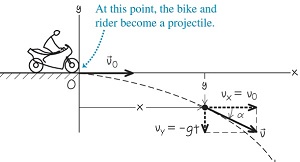CBSE 11TH PHYSICS - Online Test
Let be the angular velocity of the Ring of Mass M , thus the moment of inetia about given axis is I1 = and the four point objects are genlty placed at perpendicular diameters at opposite end, so thus the distance of each object from axis of rotation is R, so total moment of inetia of ring and four objects is I2 =
According to law of conservation of angular momentum I1 = I22 , So on solving =

A brass boiler has a base area of 0.15 m2 and thickness 1.0 cm. It boils water at the rate of 6.0 kg/min when placed on a gas stove. Estimate the temperature of the part of the flame in contact with the boiler. Thermal conductivity of brass = 109 J ; Heat of vaporization of water = 2256
Base area of the boiler, A = 0.15 m2
Thickness of the boiler, l = 1.0 cm = 0.01 m
Boiling rate of water, R = 6.0 kg/min
Mass, m = 6 kg
Time, t = 1 min = 60 s
Thermal conductivity of brass, K = 109 J s –1 m–1 K–1
Heat of vaporisation, L = 2256 × 103 J kg–1
The amount of heat flowing into water through the brass base of the boiler is
..........(1)
where,
T1 = Temperature of the flame in contact with the boiler
T2 = Boiling point of water = 100°C
Heat required for boiling the water
Q = mL ....… (ii)
Equating equations (i) and (ii), we get:
∴ mL = KA(T1 - T2) t / l
T1 - T2 = mLl / KAt
= 6 × 2256 × 103 × 0.01 / (109 × 0.15 × 60)
= 137.98 o C
Therefore, the temperature of the part of the flame in contact with the boiler is 237.98°C.
length, l = 4.234 m
breadth,b = 1.005 m
thickness, t = 2.01 cm = 2.01 × 10-2 m Area of the sheet = 2 (l × b + b × t + t × l) = 2 (4.234 × 1.005 + 1.005 × 0.0201 + 0.0201 × 4.234) = 2 (4.3604739) = 8.7209478 m2
As area can contain a maximum of three significant digits, therefore, rounding off, we get Area = 8.72 m2
Initial velocity u = 0 m/s
final velocity = v
Time t = 2 s
Acceleration a = 1 m/s2
We know,
v = u + at
=> v = 2 m/s
The motorcycle’s x- and y-coordinates at t=0.50 s are

x = vox t= =4.5 m
y= = -1.2m
The negative value of y shows that the motorcycle is below its starting point.
The motorcycle’s distance from the origin at t=0.50 s is r= =4.7 m
